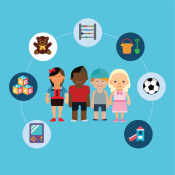Critical Information
The number of children ages 3 to 17 struggling with anxiety or depression rose by 1.5 million between 2016 and 2020. Educators trained in resilience will fortify their students and raise their potential for learning.
Two modes for promoting student resilience
Synchronous solutions…
include facilitated small group discussion, coaching, workshops, and more. Our unique web events include live group therapy, humor workshops to infuse fun into the classroom and even live events with comedians. Enjoy the video example.
Asynchronous solutions…
include on-demand video engagements on a range of topics from autism to dealing with difficult students. Faculty (and parents) can learn the rubric for developing greater resilience, will pass along this learning to students. Please enjoy this video montage on student engagement from our on-demand video library.
On-demand virtual engagements

SEL Themed Virtual Play Part III
A world changing pandemic spawned a radical shift into virtual instruction, pushing students and educators to their limit. Watch this high school class navigate their social emotional struggles.

Suicide Prevention & SEL Part IV
Surveyed teachers report a significant decline in characteristics such as independence and self-control. Explore why this is and the relation to self-harm.

Suicide Prevention & SEL Part VI
Self-reflective practices are the key to understanding where personal growth work lies. If an educator looks inward, they can help students learn to do the same.

Suicide Prevention & SEL Part VII
Perhaps the most challenging of all the PSEL's, integrating frailties and inequities. A teacher is brought on stage to take this challenge on.

Suicide Prevention Part I
Every 12.3 minutes there is a death by suicide in the United States. Learning what signs to look for and how to intervene can save a life.

Technology or Wellness Part I
Dr. Jared Scherz partners with Principal Keith Swaney, presenting at the NJASA TECHSPO Conference. The question they attempt to answer is whether technology and wellness can co-exist.

The Me I Foresee Part I
A social emotional musical created by the oldest theatre in the country. Great for teachers to generate discussion with their class. Ideal for ages 7-12.

The Me I Foresee Part II
Teach our young minds “What we focus on EXPANDS” using daily affirmations with a writing prompt! By selecting attention, students will appreciate the power of cognitive reframing to regulate mood.
Success Stories

"Whole School Health Through Psychosocial Emotional Learning highlights the importance of relationships, communication, and compassion for others. It presents a critical view in supporting, training, and retaining teachers through the lens of engaging and modeling behaviors that will help our rural students be better civic leaders and community members. My favorite quote from the book gives credit to the author's upbringing and modeling from his parents: 'We must experience the world through others so we can fully engage in educating all children. My father and mother modeled to me and my siblings how to experience the world through somebody else’s eyes, especially if their outer differences stirred up discomfort or displeasure, enriching all lives involved.' I recommend all leaders, teachers, and stakeholders secure their copy as they prepare for school."
Allen Pratt, Executive Director, National Rural Education Association (NREA)